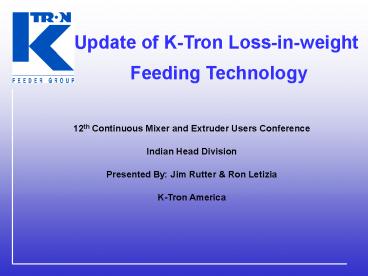Update of K-Tron Loss-in-weight - PowerPoint PPT Presentation
1 / 35
Title:
Update of K-Tron Loss-in-weight
Description:
Update of K-Tron Loss-in-weight Feeding Technology 12th Continuous Mixer and Extruder Users Conference Indian Head Division Presented By: Jim Rutter & Ron Letizia – PowerPoint PPT presentation
Number of Views:218
Avg rating:3.0/5.0
Title: Update of K-Tron Loss-in-weight
1
Update of K-Tron Loss-in-weight Feeding
Technology
12th Continuous Mixer and Extruder Users
Conference Indian Head Division Presented By Jim
Rutter Ron Letizia K-Tron America
2
Overview
- Review of Loss-in-weight Feeders
- Choosing the Proper Feeder
- Advances in Loss in Weight Feeders for
- Enhanced Performance
- Getting Valuable Data From Your Feeders
3
Loss-in-weight Principle
Feeder and material are continually weighed, and
metering speed is controlled to maintain desired
discharge rate.
4
Theory of Operation of a Loss-in-weight Feeder
WEIGHT
SPEED (RPM)
SETPOINT
5
Choosing the Proper Feeder For Your Application
6
Material - Physical Properties- Handling
Characteristics- Rate
Feeder - Operating Principle- Weighing System-
Control System - Mechanical System
Environment - Vibration- Temperature
ACCURACY - User Specified- Required Quality-
Minimum Cost
7
Determine the Process Performance Requirements
- Repeatability
- Linearity
8
Linearity
Linearity is a measure of flow rate error over
the full operating range
9
Repeatability
Repeatability describes flow rate variability at
a given rate setting
10
Other Considerations
- Feedrate
- Material Properties
- Refill Method
- Environment
- Control Integration
11
Designs for All Applications
12
Performance Timescales
ACCURACY
Momentary - Selection/Sizing- Weighing
Resolution- Control Response - Environment
Steady State - Measurement Stability -
Maintenance
Refill Phase - Refill Performance- Refill
Frequency
13
Advances in Loss-in-Weight Technology to Meet
High Performance Demands
14
Improved Load Cell Technology
- Higher Sampling Rates (112 samples/sec)
- Vibration - Digital Filtering
- Temperature Compensation
15
Vibration Filtering vs. Non-Vibration Filtering
16
SFT Load Cells
SFT II 200 - 1000 kg
SFT II 18 120 kg
SFT III 60 1000 N
17
Screw Speed Modulation
- Improved Short Term Accuracy
- 2 Sigma at 10 Seconds Improved
- Tremendously
- Steady Material Output
- Ideal for Low Feed Rates
18
Initial Situation
In general, an attempt at aggressive control
will fail and increase the mass flow variations.
Additionally, during volumetric phases, such as
refill or pert, the speed remains constant.
19
With Screw Speed Modulation
The periodic pulsation of material is measured
and screw speed is adjusted. The Speed Modulation
Algorithm learns when and how much the mass flow
changes periodically, and then changes the
screw speed just before there will be an
error. It continues modulation during
volumetric phases such as refill or pert.
20
Connectivity Options
- Options to Meet Any Plant Network Demands
- Ethernet Compatibility
- Wireless Capability
21
Getting Valuable Data From Your Feeder
- The Communications Link
- Collecting Data
22
Communication LinkData Concentrators
Host Computer or PLC
High Speed Network
Display/Data Concentrator
Local Display
23
Communication LinkGateways
Host Computer or PLC
High Speed Network
GATEWAY
GATEWAY
GATEWAY
Local Display
24
Communication LinkDirect Connection To Feeder
TREND
- No Bottlenecks
- Less Components
Host Computer or PLC
High Speed Network
Local Display
25
Direct Connection To Your Feeder
Whats Important?
CONTROLLER
- Ease of Setup
- Reliability
- High Speed/Data Throughput
- Deterministic
- Supports large data transfers
26
What Protocol To Use?
- Modbus RTU / ModbusPlus
- AB DF1, Siemens 3964R
- Profibus DP
- DeviceNet / ControlNet
- Ethernet-Modbus / TCP
- Ethernet-Ethernet / IP
CONTROLLER
27
Ethernet For Control TREND
- High Speed
- Proliferation of Products
- Open Fieldbus Standards
- Modbus/TCP (Modbus over Ethernet)
- Ethernet/IP (DeviceNet over Ethernet)
- Reliability?
- Deterministic Question?
28
Ethernet Determinism
- Ethernet does not provide consistent latency due
to arbitration - algorithm called Carrier Sense Multiple Access
with Collision - Detection (CSMA/CD).
Delays Due To CSMA/CD Two Node Packet
Collision BandWidth 100 Mbits/sec, 1000
packets/sec 128 byte packet 99 sure will run
1140 years without gt 1 msec delay 1024 byte
packet 99 sure will run 2 years without gt 1
msec delay (Source Can Ethernet Be Real
Time, Real-Time Innovations, Sunnyvale, CA)
29
Ethernet Determinism
- Switches vs. Hubs
- Switches virtually eliminate all collisions
- by buffering packets
- Max delay can be calculated
- Slower on lightly loaded networks due
- to imposed delays.
30
Collecting Data
- Who uses the data?
- (Operations, Maintenance Personnel, Quality
Control) - Can the communications link eliminate I/O?
- Can the data help determine end product quality
and help with end product validation? - What control functions are required?
31
Collecting Data
Advanced feeders provide a wealth of information
- Real-time access to all process data and
parameters - Access to diagnostic and service related
information - Provides data and control functions for other
feeder related components (such as pre-feeders
and loaders) - Quick start built-in configurations to reduce
learning-curve - Flexibility in configuration
32
Customizing Data Collection
PC based tools help determine what parameters and
data types will be exchanged.
33
Using Feeder Data
Process data can be used to predict
end-product quality problems or equipment
failures before they occur.
- Periodic catch samples validate feeder operation.
Periodic end-product analysis validates the
product. - Proactive approach may include collecting data in
real time and statistically comparing it to
known-good data to determine if run is likely
to produce good end-product.
34
Conclusions
- Trends toward direct feeder communications with
high speed protocols - Industrial Ethernet gaining acceptance
- Important to have access to all data with easy
customization - Advantages to integrating feeder related
equipment - Real-time data can be useful to predict problems
and ensure end product quality
35
www.ktron.com
WORLD HEADQUARTERS K-Tron International Routes 55
553 PO Box 888 Pitman, NJ 08071-0888 USA
SWITZERLAND K-Tron (Schweiz) AG Industrie
Lenzhard CH-5702 Niederlenz Switzerland
SINGAPORE K-Tron Asia Pte, Ltd. 10 Bukit Batok
Crescent 04-05 The Spire SG-658079 Singapore































